The Cost of an Oil Change Is a Lot Less If You Do It Yourself. Here’s What You Need to Know

It’s the last expense you really want to think about: The cost of an oil change that can run $70, $90, $100 or more. But every car needs regular oil changes to keep it running smoothly and to extend its life. This is a skill I learned when I started racing and working on my own cars, and now, it’s one that comes as naturally as doing the laundry, but is a lot more rewarding.
The good news is that you can change your own oil safely at home, and with the right materials, the cost of an oil change is $35 or so; you can save money and ensure it’s done right. You’ll need a short list of supplies, some basic tools and your owner’s manual, but with those things you’re on your way to mastering this easy bit of car maintenance.
This story is 100% human researched and written based on actual first-person knowledge, extensive experience and expertise on the subject of cars and trucks. No AI was used.
Step 1: Warm Up Your Car – And the Oil
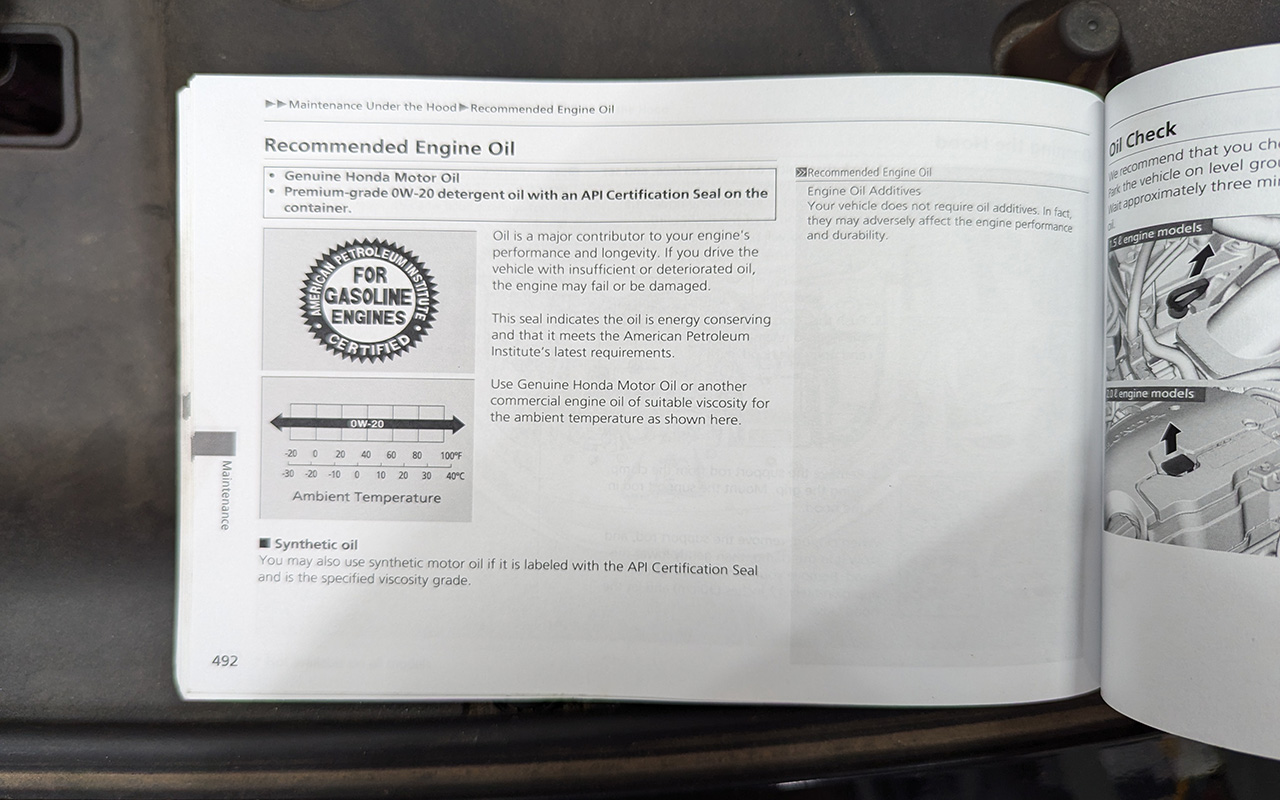
First, warm your engine up a bit. Cold oil will drain very slowly, and likely won’t drain to the same extent as warm oil. However, be careful not to get the oil too hot, or you may burn yourself!
To be safe, it is best to run your engine for 2-3 minutes. At about 100 degrees, this should lower the oil’s viscosity while keeping you safe from burns. On the other hand, if the oil is too hot, let it settle and cool down for a few minutes after turning off the engine.
Read: Car Maintenance Made Easy: Best Paint Remover for Cars
Step 2: Jack Up Your Car

Securely raise your vehicle in the air if needed. This will help you access the oil pan and its drain plug. For your safety, please ensure to always change your oil on level ground, whether you are lifting it in the air or not.
Please refer to the manufacturer’s instructions on proper use of the jack and jack stands or the service ramps. If you own an SUV or truck, you can likely perform the oil change without lifting the vehicle in the air.
Read: 5 Car Maintenance Checklist Tips to Save You Time and Money
Step 3: Find the Drain Plug

Locate the oil drain plug. Most modern cars will have an under tray beneath the vehicle. This is a plastic panel that covers the bottom of the engine and aids in keeping the engine clean, as well as increasing gas mileage. Many modern vehicles will have oil service panels so that you can do an oil change without removing the entire tray. Use the required tools to remove these panels, or the whole tray if necessary.
Refer to your owner’s manual for oil service panel locations. The oil pan will look like a square or rectangular tray with rounded edges on the bottom of the engine. Locate the oil pan and look for a bolt on the lower side or on the bottom. This is your oil drain plug.
Read: Winter Car Maintenance: Tips to Prep Your Car for Frigid Temps
Step 4: Prepare to Drain

Position your oil drain pan beneath the drain plug. You will also want the drain pan to be easy to reach once the oil starts draining. If you haven’t yet, put on your disposable gloves.
Step 5: Remove the Drain Plug
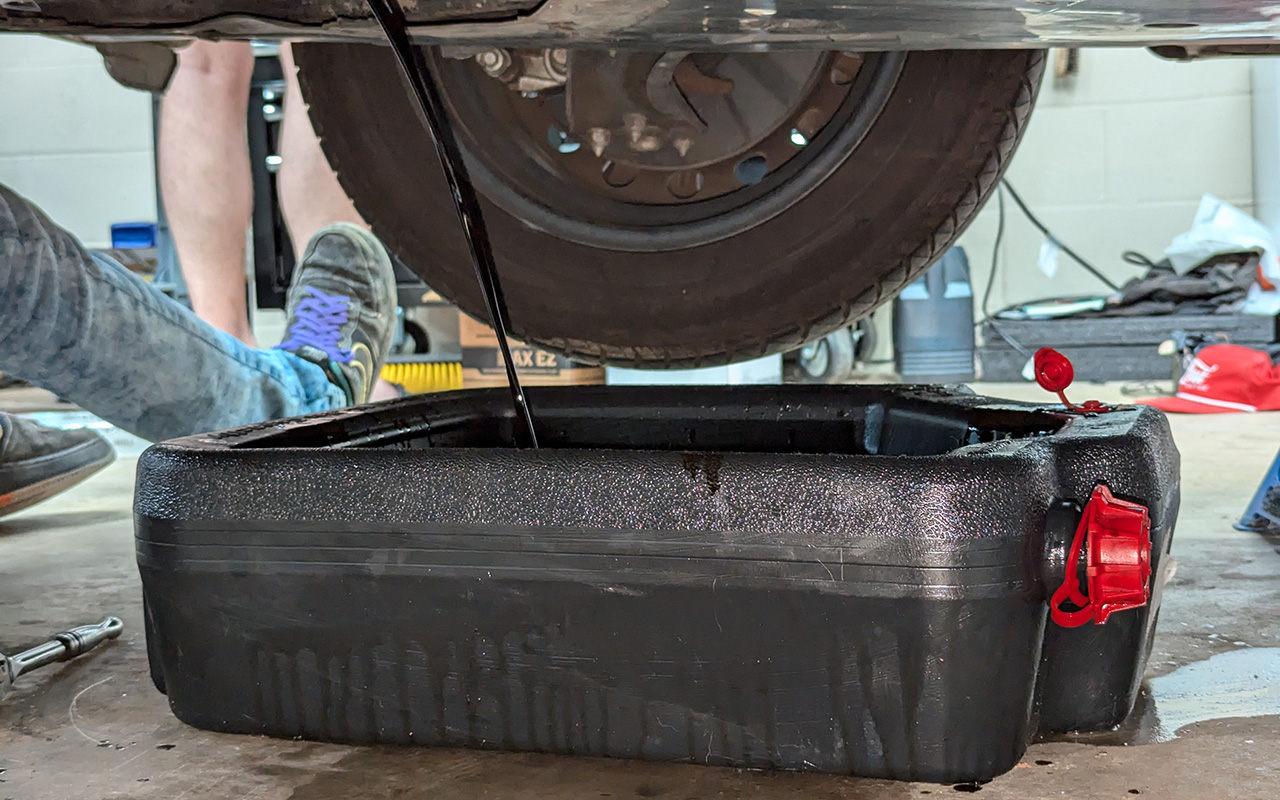
You are now ready to remove the oil drain plug. Using a wrench or ratchet, loosen the plug. It should be tight at first, but once it starts turning, it should become finger-tight very quickly. This is where a little bit of finesse comes in.
Once the plug is finger-tight, I set the wrench off to the side and do the rest by hand. With one hand ready to move the oil drain pan in case I positioned it incorrectly, I use the other hand to quickly loosen the plug. I like to push the plug in while loosening it until I feel the last couple threads. This helps prevent premature leaking. Once I feel the last thread give way, I quickly pull the plug away to avoid making too big of a mess.
If your plug is on the side of the oil pan, perpendicular to the ground, keep in mind that the oil stream will initially arc away from the oil pan, and will gradually move as the stream slows. Keep an eye on your drain pan to make sure you don’t make any messes!
Step 6: Replace the Oil Filter
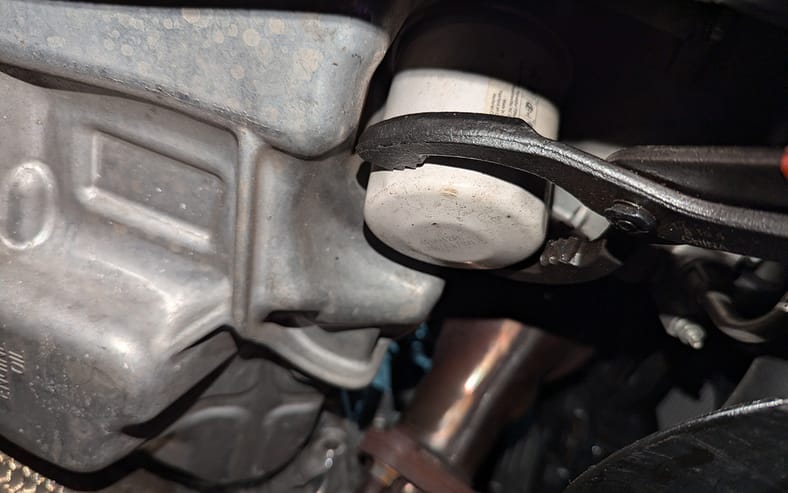
While the oil drains, locate your oil filter. For many, this will be the toughest part (at least the first time). Manufacturers put oil filters in all sorts of locations. It could be on the front, back, side, bottom, or top of your engine. Refer to your owner’s manual to locate the filter, and use the new filter as a reference for what you are looking for.
Canister type oil filters will be located in a black cylinder (the canister). In order to replace these, you will need to use a socket to remove the lid of the canister. Then, you can lift the old filter out and replace it with the new filter. The lid of the canister will have a large rubber o-ring around the top. It is recommended to replace this o-ring with every oil change. You can shimmy it off with your fingers, or since your fingers will likely be slippery with oil, use a small flathead screwdriver or a pick to slip it off. Replace the canister cap and tighten down to the factory torque specification, which will be noted in your owner’s manual, and/or written directly on the canister lid.
Step 6 Continued: Tips for Replacing Your Oil Filter

Screw-on oil filters will not be in a canister, but rather will screw directly onto the engine. The screw-on oil filter pictured above is facing directly downwards, towards the ground. You will likely need to use the oil filter wrench to loosen this initially.
When removing a screw-on filter, remember that there will be oil within the filter, so use caution when removing from the engine to keep the mess minimal. As long as you keep the filter tilted with the opening up, no oil can leak out!
These filters have a built-in o-ring. Dip your finger in the old oil and lightly grease the o-ring on the new oil filter before twisting it back onto the engine. Do not use a wrench to tighten a screw-on oil filter. Using your hand to tighten down as snug as you can should do the trick! We do not want to overtighten these oil filters!
Step 7: Replace the Drain Plug
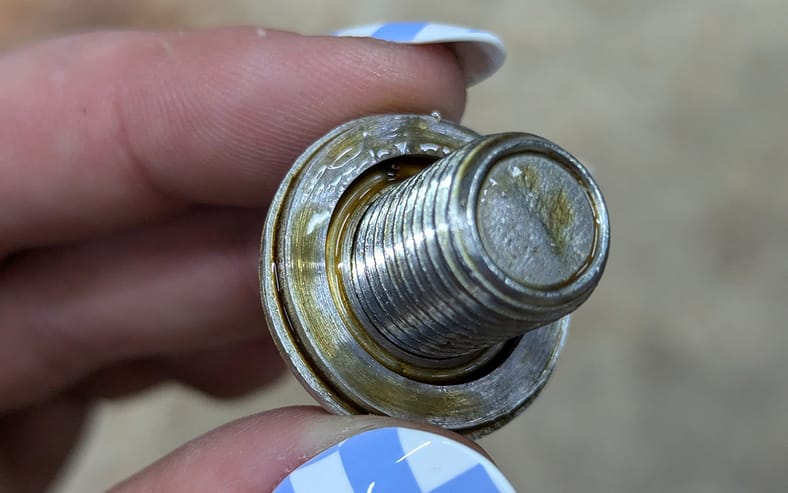
By this point, your oil should have finished draining. If there is still a trickle leaking out, it is okay. You can go ahead and call it. Replace the oil drain plug. If your drain plug has a washer on it, as pictured above, it is recommended to replace this washer. Please note, this is not a normal washer. It is called a “crush washer” and can be purchased at your local parts store.
Screw the plug back in by hand, and use the wrench or ratchet to snug it up. It should get tight and mostly stop turning. Do not force this too tight – get it snug with the wrench and stop. Like the screw on oil filters, we don’t want to overtighten this.
Step 8: Remove the Oil Fill Cap

Next, remove the oil fill cap, preferably with your car lowered back down to the ground. To locate this cap, look for a typically black cap with the oil symbol on it, like the cap pictured below.
It will often be on the top of the engine, towards the middle of the engine bay. Set this to the side. Also remove the oil dipstick. To locate the dipstick, look for a handle, typically yellow. Loosen the dipstick, but note that it is not necessary to remove completely. If you cannot find a dipstick, your car may not have one! Many modern vehicles have an electronic oil level sensor in lieu of a dipstick.
Step 9: Refill Your Oil
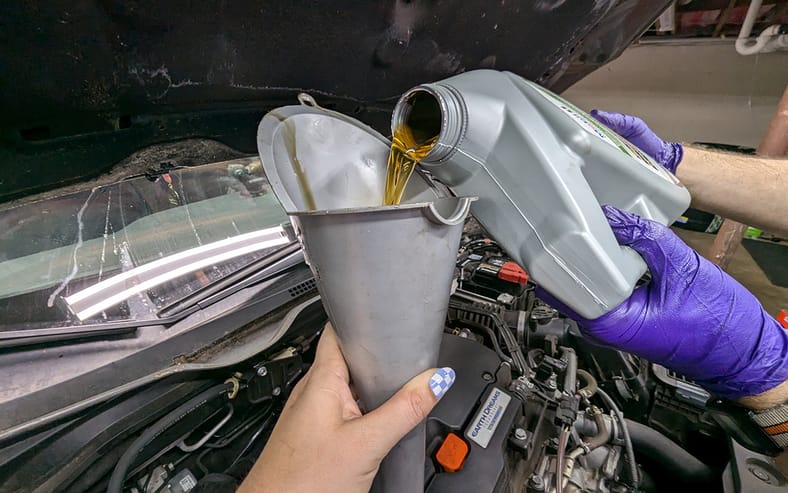
Finally, it’s time to refill your oil. Now that your drain plug and oil filters are secure, it is time to pour in the new oil. It is likely that some of the old oil has remained in your engine. That is okay! It is close to impossible to get all of the old oil out. Because of this, I recommend pouring in about 0.5 quarts less than the manufacture-listed capacity before your initial level check. Place a funnel (the longer the better) into the oil fill hole. Carefully pour in the appropriate amount of oil.
Step 10: Check Your Work
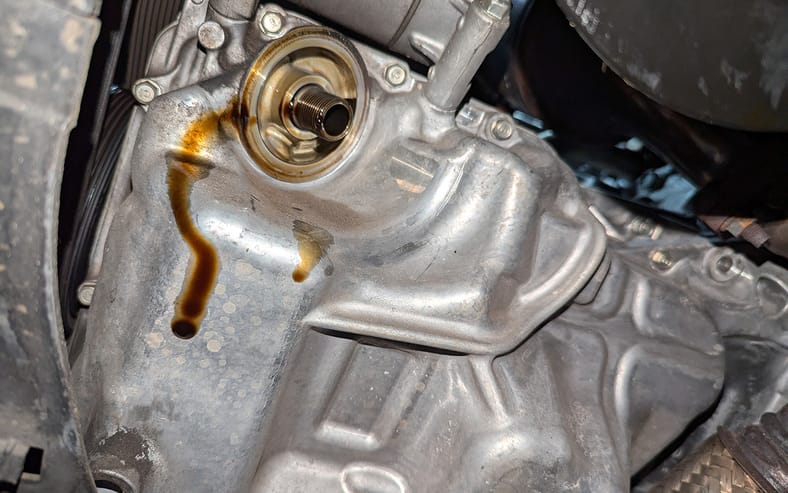
Check your oil level. Once you have poured in what you believe is the correct amount of oil, check the oil level. If your car is on jack stands, return it to flat ground before doing this. If your car is on ramps and you can roll it off the ramps in neutral, do so. If not, check to ensure some oil is registering on your dipstick prior to starting your car and driving off the ramps.
Use the dipstick to check the oil level, without turning the car on. To do this, pull out the dipstick, wipe the end clean with a rag or paper towel, then slide the dipstick back into place. Put the dipstick in all the way, then remove again. Look at the end of the dipstick and read the level, as marked. If the oil is sitting between the “low” and “high” marks, you have added enough oil! If it’s at or below “low,” then add more oil. If it’s above “high,” you will need to get back under the car and drain just a little oil. This is a pain, which is why I recommend erring on the side of adding too little oil before the initial level check.
Step 10 Continued: Tips for Checking Your Oil Levels

Sometimes it can be a little challenging to see the level of new oil because the oil is practically clear. I recommend looking for the “shiny stuff.” If you look closely in the photo above, you can see where the shiny stuff ends is just a hair above the “high level” line. Since the level is just barely high, I plan to drive the car a little bit to let the oil run through the engine and fill all the nooks and crannies. Then I’ll check the level again. I expect it to drop down to, or below, the “high level” line. However, if it does not, I will need to drain just a tiny bit of oil.
Remember, if you do not have a dipstick, your vehicle is using an electronic oil level sensor. Check this level without starting the car. To do this, turn the key to the “on” position without cranking the car. In a push-to-start car, press the “on” button with your foot off the brake pedal. Scroll through the appropriate menus in your multimedia screen or on your driver display to find the oil level reading. If you are unsure of where this setting is, refer to your owner’s manual.
Step 11: Cleaning Up
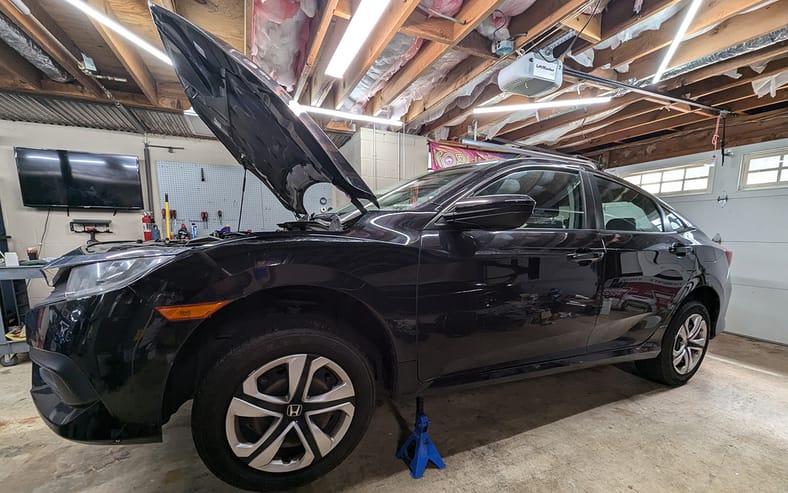
Replace the dipstick and oil fill cap. Wipe up any spiled oil in the engine bay, and you are done! I recommend checking the oil level again after your first drive post-oil change to make sure it still falls in the acceptable range after flowing through the engine.
If your vehicle has an electronic service reminder (you know, that pesky light that we like to ignore that says “service due”), you will need to reset the service interval. Refer to your owners manual for instructions on how to do this.
Step 12: Dispose of Old Oil and Buy New Oil- Keeping the Cost of an Oil Change Down
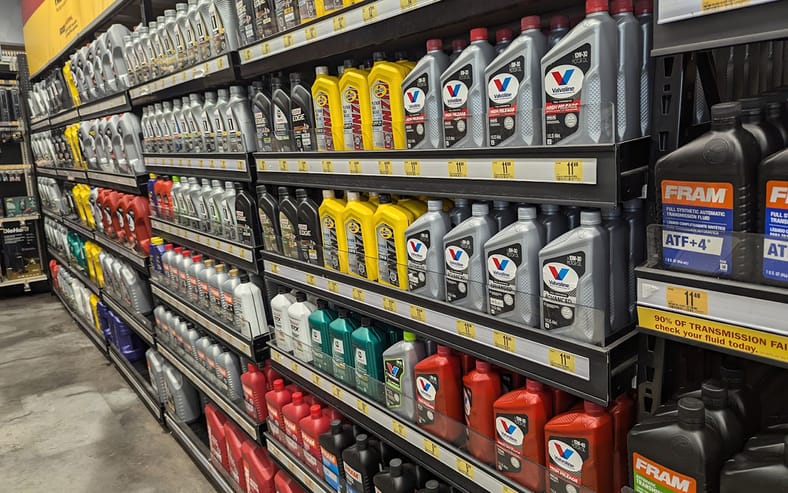
Dispose of your old oil at your local parts store. Do not pour it down the drain or in a storm drain. Your local parts store more than likely has an oil recycling drum in the back of the store. I have never been to an Advance Auto Parts, Auto Zone, or O’Reilly’s that didn’t! Also, bring your old oil filter with you. Many parts stores will recycle these too, or they’ll at least know a local company that does. And while you’re there you can stock up on supplies for next time.
Congratulations! You just completed your first oil change on your own! Once you get the hang of the process, it will become second nature. The cost of an oil change is less and take less time than bringing your vehicle to a shop. I do my own oil changes in five minutes – which is much less time than it takes for me to drive to a shop, check in, wait on my car, pay, and drive home.
Categorized:Car Maintenance





